Related Research Articles

The Archdiocese of Florence is a Latin Church metropolitan see of the Catholic Church in Italy. It was traditionally founded in the 1st century, according to the 14th century chronicler Giovanni Villani. The diocese was directly subordinate to the Holy See (Papacy) until 1420.
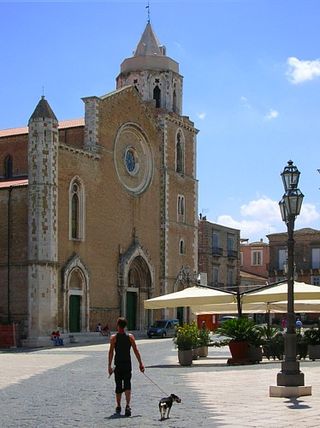
The Diocese of Lucera-Troia, sometimes called Nocera, is a Latin diocese of the Catholic Church in Apulia, in southern Italy, with its episcopal seat at Lucera Cathedral. The diocese reached its present configuration in 1986, by combining the older diocese of Lucera with the diocese of Troia, the seat of which was Troia Cathedral, now a co-cathedral of the united diocese.
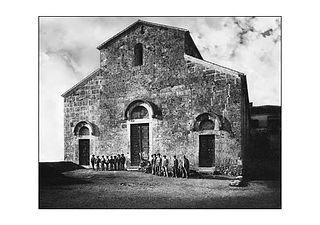
The Roman Catholic diocese of Ferentino existed until 1986, when it was united into the new diocese of Frosinone-Veroli-Ferentino.

The Diocese of Rieti is a Latin Church ecclesiastical territory or diocese of the Catholic Church in Italy. It is immediately exempt to the Holy See. Its cathedra is in St. Mary Cathedral in the episcopal see of Rieti.
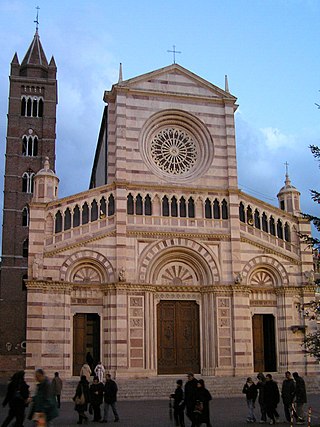
The Diocese of Grosseto is a Latin Church diocese of the Catholic Church in Italy, a suffragan of the archdiocese of Siena-Colle di Val d'Elsa-Montalcino, in Tuscany. Its current bishop is Giovanni Roncari, OFMCap.
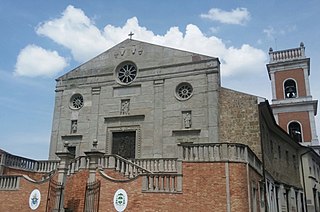
The Diocese of Ariano Irpino-Lacedonia is a Latin diocese of the Catholic Church. It is a suffragan of the Archdiocese of Benevento.
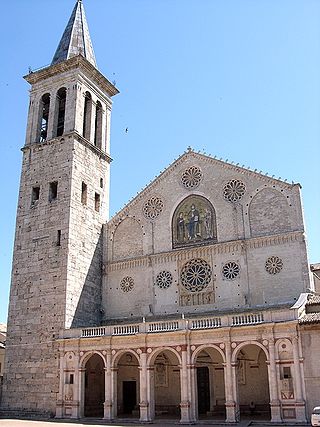
The Archdiocese of Spoleto-Norcia is a Latin Church ecclesiastical territory or archdiocese of the Catholic Church in Italy. Historically, it was the Diocese of Spoleto. Elevated to the status of an archdiocese since 1821, it is a non-metropolitan see and is immediately exempt to the Holy See.
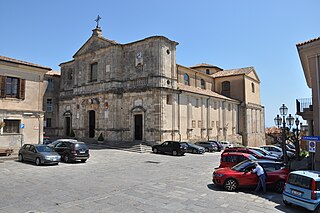
The Diocese of Squillace was a Latin Church ecclesiastical jurisdiction or diocese of the Catholic Church in Calabria, Italy. The diocese was established in the 5th century, and suppressed in 1986. In that year, it was combined into the Archdiocese of Catanzaro-Squillace. It was a suffragan of the archdiocese of Reggio in Calabria.

The Roman Catholic diocese of Bobbio was an Italian bishopric which existed from 1014 until 1986. The diocese was formed from the territory of the Abbey of Bobbio.
The Catholic diocese of Sarsina was a Roman Catholic ecclesiastical territory in Emilia-Romagna, northern Italy, seated in Sarsina, in the province of Forlì, some 32 km south-southwest of Cesena. The diocese was founded in the 5th century, and was suffragan (subordinate) to the archbishop of Ravenna. The diocese existed until 1986, when it was united with the diocese of Cesena.

The Diocese of Alife-Caiazzo is a Latin diocese of the Catholic Church in Campania, southern Italy, created in 1986. In that year the historic Diocese of Alife was united with the Diocese of Caiazzo. The diocese is a suffragan of the Archdiocese of Naples.

The Diocese of Melfi-Rapolla-Venosa is a Latin diocese of the Catholic Church in Basilicata, southern Italy. In 1986 the historic Diocese of Melfi-Rapolla was united with the Diocese of Venosa. The diocese is a suffragan of the Archdiocese of Potenza-Muro Lucano-Marsico Nuovo. The Abbey of the Santissima Trinità at Venosa comes under the Diocese.
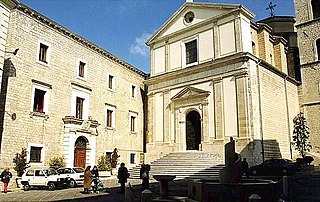
The Archdiocese of Potenza-Muro Lucano-Marsico Nuovo is a Latin diocese of the Catholic Church in Basilicata, southern Italy, created in 1986. In that year the Diocese of Muro Lucano was united into the Archdiocese of Potenza e Marsico Nuovo, which had been elevated to an archdiocese in 1973, and made a metropolitan see in 1976. The historical Diocese of Potenza was united with the Diocese of Marsico Nuovo in 1818.
The Latin Catholic Diocese of Muro Lucano, in the southern Italian region of Basilicata, existed until 1986. In that year it was united into the archdiocese of Potenza-Muro Lucano-Marsico Nuovo.

The Diocese of Sessa Aurunca is a Latin diocese of the Catholic Church in southern Italy. Since 1979 it has been a suffragan of the Archdiocese of Naples.
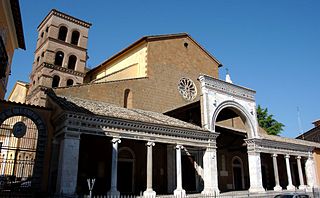
The Diocese of Civita Castellana is a Latin Church ecclesiastical territory or diocese of the Catholic Church in Latium, central Italy. It has existed in the current form since 1986, when the Diocese of Nepi e Sutri was united into the Diocese of Civita Castellana, Orte e Gallese. The Diocese of Gallese had been added to the Dioceses of Civita Castellana and Orte in 1805. The name of the diocese was shortened in 1991, in accordance with Vatican policies. The diocese of Civita Castellana is immediately exempt to the Holy See.

The Diocese of Tursi-Lagonegro is a Latin diocese of the Catholic Church in Basilicata, southern Italy. It is a suffragan of the Archdiocese of Potenza-Muro Lucano-Marsico Nuovo.
The Diocese of Acerno was a Roman Catholic diocese based in Acerno, a distance of 68 km (42 mi.) from Naples in southern Italy, with the bishop's seat in Acerno Cathedral. Created in the 11th century, in 1818, the diocese was granted in perpetual administratorship to the archbishops of Salerno. In the reorganization of ecclesiastical provinces in 1986, Acerno was suppressed, to create the Archdiocese of Salerno-Campagna-Acerno.
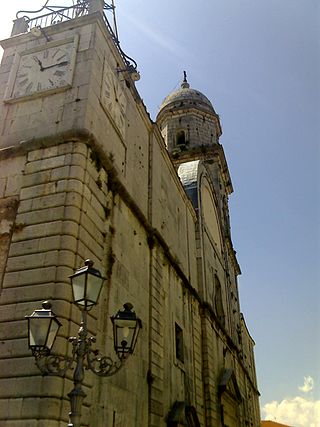
Diocese of Nusco was a Roman Catholic ecclesiastical territory in Campania, southern Italy, and was a suffragan of the archdiocese of Salerno. In 1986 the diocese was suppressed, and its territory was united with the archdiocese of Conza-Sant'Angelo dei Lombardi-Bisaccia, to form the Archdiocese of Conza-Sant'Angelo dei Lombardi-Nusco-Bisaccia.

The Roman Catholic Diocese of Ortona a Mare e Campli was a Roman Catholic diocese in Italy, located in the city of Ortona, in the Province of Chieti in the Italian region of Abruzzo. In 1834, it was united with the Archdiocese of Lanciano to form the Archdiocese of Lanciano.
References
- ↑ union of two dioceses kept separate, but under the rule of one and the same bishop
- ↑ Cheney, David M. "Diocese of Marsico Nuovo". Catholic-Hierarchy.org . Retrieved June 16, 2018. [self-published]
- ↑ Chow, Gabriel. "Diocese of Marsico Nuovo (Italy)". GCatholic.org. Retrieved June 16, 2018. [self-published]
- ↑ Cappelletti XX, pp. 381-383.
- ↑ Benigni, Umberto (1910). . Catholic Encyclopedia . Vol. 9.
p. 324, indicating that the earliest reference is in the mid-twelfth century
- ↑ Sempronius is rejected by Lanzoni, p. 324: "tarda e favolosa fonte." Kehr VIII, p. 373, also rejects Laberius and Sempronius: "moderni interpolatoris leves sunt inventiones." Giacomo Racioppi (1881), Fonti della storia basilicatese al medio evo. L'agiografia di san Laveri del MCLXII,(in Italian) (Roma: G. Barbèra), esp. pp. 7-12.
- ↑ Lanzoni, p. 325. Kehr VIII, p. 375, no. 4.
- ↑ Philippus Jaffè (1885), Regesta pontificum Romanorum Volume I, second edition (Leipzig: Veit), p. 197, no. 1737.
- ↑ Servanzi-Collio, pp. 21-22. Kehr VIII, pp. 373-374.
- ↑ e.g. Eubel I, p. 328, note 2, a bishop Bernardus of the Marsi, not Marsico.
- ↑ Kehr, p. 373. Pflugk-Haartung (1884), Acta pontificum Romanorum inedita Volume 2 (Stuttgart: W. Kohlhammer), pp. 82-84, no. 116: "Ad haec licentiam et potestatem tuae fraternitati damus cum clero et populo, secundum sanctorum canonum statuta eligendi episcopos et ordinandi in subjectis tibi locis secundum Romanorum pontificium privilegia, hoc est, in Pestanensi civitate, et in civitate Consana, et in civitate Acerenina, et in Nolana, quoque et Cusenta, nec non et in Visinianensi, et in Malvito et in Policastro et in Marsico et in Martirano et Caciano, cum omnibus parrochiis et adiacentiis eorum."
- ↑ Ritzler and Sefrin Hierarchia catholica VI, p. 278, note 1.
- ↑ Ughelli VII, pp. 501, 508. Kehr VIII, pp. 375-376.
- ↑ Torelli, pp. 117-118, § 6. Bullarii Romani continuatio, Summorum Pontificum Clementis XIII, Clementis XIV, Pii VI, Pii VII, Leonis XII Gregorii XVI constitutiones... (in Latin). Vol. Tomus decimus quintus (15). Rome: typographia Reverendae Camerae Apostolicae. 1853. p. 57 § 9.
- ↑ Christus Dominus 40. Therefore, in order to accomplish these aims this sacred synod decrees as follows: 1) The boundaries of ecclesiastical provinces are to be submitted to an early review and the rights and privileges of metropolitans are to be defined by new and suitable norms. 2) As a general rule all dioceses and other territorial divisions that are by law equivalent to dioceses should be attached to an ecclesiastical province. Therefore dioceses which are now directly subject to the Apostolic See and which are not united to any other are either to be brought together to form a new ecclesiastical province, if that be possible, or else attached to that province which is nearer or more convenient. They are to be made subject to the metropolitan jurisdiction of the bishop, in keeping with the norms of the common law. 3) Wherever advantageous, ecclesiastical provinces should be grouped into ecclesiastical regions for the structure of which juridical provision is to be made.
- ↑ The bull Eo quod spirituales (in Latin), in: Acta Apostolicae Sedis 68 (1976), pp. 678-680.
- ↑ Acta Apostolicae Sedis 79 (Città del Vaticano 1987), pp. 764-766.
- ↑ Ughelli VII, p. 497, found only in a story of the transferral of relics. Grimaldus is rejected by Lanzoni, p. 326, as another hagiographical invention without any sort of support.
- ↑ Kehr VIII, p. 374.
- ↑ Giovanni was a monk of the Benedictine congregation of Montecassino. In 1095 he signed a document: "ego Joannes episcopus civitatis Marsensis (sic) sedis Grumentine." He is referred to in a document of December 1097 as: "domno Joanne venerabilis episcopus sante sedis Grumentine de civitate Marsico." Racioppi, pp. 154, 156. Mattei-Cerasoli (1919), p. 313.
- ↑ Leo signs himself, "Ego Leo, Dei gratia Grumentinae sedis Pontifex" and "Ego Leo Grumentinus Episcopus". He was one of four bishops appointed by Pope Calixtus II in 1123 to oversee the process of the canonization of S.Gerardo of Potenza. Servanzi-Collio (1867), p. 24, no xi. Cappelletti XX, pp. 385-386.
- ↑ Henricus completed the original cathedral in the city of Marsico Nuovo, finally replacing the one destroyed by the Saracens. The dedicatory inscription is dated MCXXXI. Cappelletti XX, p. 386. Mattei-Cerasoli (1919), p. 314.
- ↑ In a grant of 1144 to the monastery of Cava, Bishop Joannes is referred to as: "Nos Johannes gratia Dei Grumentane (sic) sedis episcopus," and he subscribes: "Ego Johannes Marsicanus episcopus." Racioppi, p. 157. Servanzi-Collio (1867), p. 24, no. XIII.
- ↑ In May 1163, he is referred to in a document of the archbishop of Salerno (Racioppi, p. 149) as: "Existentibus etiam ibidem Joanne venerabili marsicano episcopo suffraganeo ipsius domini archiepiscopi, Saulo archipresbitero ecclesie Saponarie, et quibusdam aliis de presbiteris ipsius ecclesie Saponarie, que marsicano episcopatui subjecta est." He subscribes a document: "Ego Johannes tercius huius nominis Marsicanus episcopus concessi et ordinavi." Mattei-Cerasoli (1919), pp. 314-315.
- ↑ Johannes (IV) is referred to in a document of King William II (Racioppi, p. 147): "concedo et offero ecclesiæ S. Antonini de Saponaria, in manibus domini Joannis v(enerabilis) episcopi Marsicen." Eubel I, p. 328.
- ↑ Rogerius: Servanzi-Collio (1867), p. 25, no. XVIII. Eubel I, p. 328.
- ↑ Reginald of Leontini or Lentino was transferred by Pope Gregory X to the diocese of Messina in Sicily on 5 December 1274. Eubel I, p. 337 with note 4.
- ↑ Rainaldus (Reginaldus) was appointed by Pope Gregory X on 22 June 1275. Eubel I, p. 328.
- ↑ Giovanni V: Mattei-Cerasoli (1919), p. 315. Eubel I, p. 328.
- ↑ Servanzi-Collio, p. 28, no XXXVII.
- ↑ Nardellus: Eubel I, p. 328, with note 6.
- ↑ Carletus had been Archdeacon of Sorrento. He was appointed bishop of Marsico by Pope Eugenius IV, and made arrangements for the payments for his bulls on 27 April 1440. Servanzi-Collio, p. 28, no XL. Eubel II, p. 186.
- ↑ Leonardo was appointed bishop of Marsico by Pope Nicholas V. Servanzi-Collio, p. 28, no XLI. Eubel II, p. 186.
- ↑ Pietro was a native of Naples, and held the degree Doctor in utroque iure . Servanzi-Collio, p. 29, no XLII. Eubel II, p. 186, note 1.
- ↑ Andreas: Servanzi-Collio, p. 29, no XLIII. Eubel II, p. 186, note 1.
- ↑ Samson was a native of Marsico Nuovo. Servanzi-Collio, p. 29, no XLIV. Eubel II, p. 186.
- ↑ Antonio was the son of Jacopo de'Medici. A member of the Conventual Franciscans, he began to teach the "Sentences of Peter Lombard" in 1460, and in 1461 he was awarded the title of Magister and was incorporated into the University's theological faculty. He became its Dean in 1472. He served as superior in several convents of his Order, and was twice elected Provincial of the Tuscan province. On 12 July 1484, he was appointed Bishop of Marsico by Pope Sixtus IV, a fellow Franciscan. He died within a year, and was succeeded on 12 August 1485 by Fabricius Guarna. Luca Giuseppe Ceracchini, Fasti teologali ouuero notizie istoriche del collegio de' teologi della Sacra Vniuersità fiorentina dalla sua fondazione sino all'anno 1738. (in Italian) (Firenze: Ferdinando Moücke 1738), pp. 160-161. Servanzi-Collio, p. 29, no XLVII. Eubel III, p. 236
- ↑ Boccaferro was a Bolognese patrician. When Cardinal Alessandro Farnese (Pope Paul III) had been legate in Bologna, he became friends with Boccaferro, who was then abbot of S. Michele in Bosco. He had been Abbot Visitor of his Order. He was named Bishop of Marsico by Pope Paul III in the consistory of 10 January 1536. He actually served as papal Majordomo. In April 1537, the pope game him a house. He died in Rome, and was buried in Santa Maria Nuova. Gaetano Moroni, Dizionario di erudizione storico-ecclesiastica Vol. 41 (Venice: Emiliana 1846), pp. 254-255. Servanzi-Collio, p. 30, no. L. Eubel III, p. 236 with note 3.
- ↑ Archilegi was a privy chamberlain of Pope Paul III, and then the papal Majordomo in succession to Bishop Boccaferro. He was appointed Bishop of Marsico in the consistory of 24 September 1537. On 4 Feb 1541, Pope Paul III appointed him Bishop of Assisi, where he died on 23 May 1543. Gaetano Moroni, Dizionario di erudizione storico-ecclesiastica Vol. 41 (Venice: Emiliana 1846), p. 255. Servanzi-Collio, p. 30, no. L. Eubel III, pp. 120 with note 6; 236 with note 4.
- ↑ Marzio Marzi was a principal secretary of the Medici family of Florence, in particular Duke Cosimo I. He was appointed Bishop of Marsico by Pope Paul III on 11 February 1541, but continued to work for the Medici. He first visited his diocese of Marsico on 1 May 1558, on the demand of his metropolitan, Girolamo Seripando of Salerno. He departed for the Council of Trent on 3 October 1561, and participated until the closing session on 4 December 1563. He then visited Venice, and undertook a stay in Tuscahy, where he resigned most of his benefices, in accordance with the decrees of the Council. He returned to Marsico early in 1565. He departed again, on a visit to Venice in 1573, where he resigned his bishopric in favor of his nephew Angelo, on 15 October 1474. He died in Venice on 11 November 1574. Eubel III, p. 236 with note 5. Vanna Arrighi, "Marzi Medici, Marzio," (in Italian), in: Dizionario Biografico degli Italiani Volume 71 (2008).
- ↑ Angelo Marzi was the nephew of Bishop Marzio Marzi. Servanzi-Collio, p. 30, no LIII. Eubel III, p. 236 with note 5.
- ↑ Pallavicini was a member of the family of the Marchesi di Ceva. He had been Bishop of Saluzzo (1581–1583). He was transferred to the diocese of Marsico on 8 August 1583. On 7 November 1583, Pope Gregory XIII appointed him Bishop of Nice. Cappelletti XX, p. 393. Servanzi-Collio, p. 30, no LIV. Eubel III, p. 236 with note 6; 290 with note 9.
- ↑ Servanzi-Collio, p. 30, no LIV. Eubel III, p. 236.
- ↑ Parisi died on 23 April 1614. Cappelletti XX, pp. 393-394. Eubel III, p. 236 with note 8. Gauchat, Hierarchia catholica IV, p. 233.
- ↑ Castelli: Gauchat, p. 233 with note 3.
- ↑ Ciantes: Gauchat, p. 233 with note 4.
- ↑ Pineri: Gauchat, p. 233 with note 5.
- ↑ Falvo: Ritzler and Sefrin V, p. 258 with note 2.
- ↑ Puoti: Ritzler and Sefrin Hierarchia catholica VI, p. 278 with note 2.